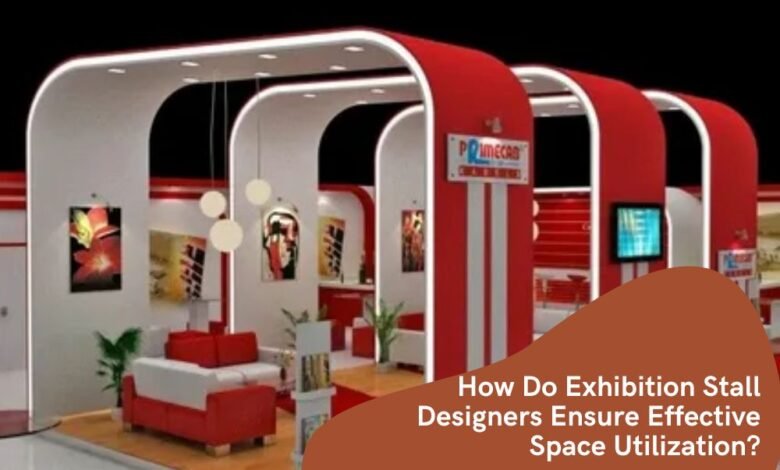
When participating in an exhibition, creating an engaging and effective stall is essential. The design of your exhibition stall can significantly impact how visitors perceive your brand and products. Effective space utilization is a key aspect of stall design that can help you attract more visitors and make a lasting impression. In this blog, we will explore how exhibition stall designers ensure that every square foot is used wisely to maximize impact.
Understanding Space Utilization in Exhibition Stalls
Before delving into the strategies used by exhibition stall designers, let’s first understand what space utilization means in the context of an exhibition stall.
What is Space Utilization?
Space utilization refers to how effectively the available space is used within an exhibition stall. This includes everything from the layout and design elements to the positioning of products and information. The goal is to create an inviting and functional environment that encourages visitors to engage with your brand.
Note: Choosing the right exhibition stall designers can make all the difference in your event’s success. Expert Exhibition Stall Designers Dubai specialize in creating eye-catching and functional stalls that captivate your audience. They focus on aligning your brand message with creative design elements, ensuring you stand out from the competition. Ready to take your exhibition to the next level? Connect with Mystique Exhibitions for personalized solutions that will leave a lasting impression.
Why is Space Utilization Important?
Proper space utilization is crucial for several reasons:
- Visitor Flow: A well-designed stall can guide visitors naturally through the space, making it easy for them to navigate and engage with your offerings.
- Brand Visibility: Effective space usage ensures that your brand is visible from different angles, attracting more attention.
- Comfort: A spacious and comfortable stall encourages visitors to linger, ask questions, and interact with your staff.
- Showcasing Products: Utilizing space wisely allows you to showcase your products effectively, highlighting their features and benefits.
Key Strategies for Effective Space Utilization
Exhibition stall designers employ several strategies to ensure that space is used effectively. Let’s explore some of the most important techniques.
1. Smart Layout Planning
One of the first steps in effective space utilization is planning the layout of the stall.
a. Zoning
Designers often use zoning to create different areas within the stall for various activities. For example, one zone may be dedicated to product displays, while another serves as a meeting area. This clear division helps manage visitor flow and makes the stall more functional.
b. Traffic Flow
Designers consider how visitors will move through the stall. A well-planned layout guides foot traffic naturally, preventing bottlenecks and ensuring that visitors can explore the space without feeling crowded. Placing high-interest items near the entrance can draw people in, while pathways lead them through the stall.
2. Multi-Functional Elements
Incorporating multi-functional design elements is another effective strategy for maximizing space.
a. Convertible Furniture
Using furniture that serves multiple purposes can save space. For instance, benches that double as storage or tables that can be adjusted in height for different uses help keep the stall organized and flexible.
b. Interactive Displays
Interactive displays engage visitors while utilizing space efficiently. For example, a touch screen can showcase multiple products without requiring physical samples, allowing visitors to explore your offerings while standing in one spot.
3. Vertical Space Utilization
Exhibition stalls often have height that can be leveraged for additional display space.
a. Tall Displays
Incorporating tall displays can draw the eye upward and create visual interest. Hanging banners, vertical shelving, or stacked product displays can effectively utilize vertical space, making your stall more noticeable from a distance.
b. Elevated Platforms
Designers can also use elevated platforms to create distinct areas within the stall. This not only adds depth to the design but also allows for product displays that are at eye level, making them easier for visitors to engage with.
4. Clear Branding and Signage
Effective branding and signage play a crucial role in space utilization.
a. Eye-Catching Graphics
Using large, bold graphics and clear branding helps visitors identify your stall from afar. Strategically placed signage can communicate your brand message and direct visitors to specific areas within the stall.
b. Informative Displays
Signage that provides information about your products or services can enhance visitor engagement. Well-placed informational displays guide visitors through the stall, allowing them to learn more while they explore.
5. Flexibility and Adaptability
The ability to adapt your stall to different exhibition spaces is essential for effective space utilization.
a. Modular Designs
Modular stall designs allow for flexibility in layout and configuration. Designers can easily adjust the size and shape of the stall based on the exhibition space available, ensuring that every square foot is utilized effectively.
b. Reconfigurable Elements
Using reconfigurable elements, such as movable walls or display units, allows designers to adjust the stall setup based on visitor traffic and engagement. This adaptability ensures that the stall remains functional throughout the event.
6. Engaging Lighting
Lighting can significantly impact how space is perceived and utilized.
a. Focused Lighting
Strategically placed lights can highlight specific products or areas within the stall, drawing attention and encouraging visitors to explore further. This focused lighting creates a welcoming atmosphere and enhances the overall aesthetic.
b. Ambient Lighting
Incorporating ambient lighting can create a comfortable environment that invites visitors to spend time in your stall. Soft, warm lighting can make the space feel more inviting and encourage engagement.
7. Comfort and Seating Arrangements
Providing comfortable seating arrangements can enhance the visitor experience and encourage longer stays.
a. Relaxation Areas
Designing small relaxation areas within the stall can provide a comfortable space for visitors to sit, chat, and engage with your team. This encourages more in-depth conversations and can lead to valuable connections.
b. Strategic Seating Placement
Placing seating strategically throughout the stall can create natural gathering spots. By positioning seating near product displays or information areas, designers can facilitate discussions and interactions.
The Role of Technology in Space Utilization
Technology plays a vital role in enhancing space utilization in exhibition stalls.
1. Digital Displays
Digital displays can showcase multiple products or messages in a compact format. Instead of physical samples, screens can present videos, images, and information about your offerings, allowing for a more dynamic and space-efficient display.
2. Interactive Tools
Using interactive tools, such as virtual reality (VR) or augmented reality (AR), can enhance the visitor experience without taking up much physical space. These technologies can engage visitors in unique ways and provide a memorable experience.
3. Mobile Apps
Exhibition organizers often provide mobile apps that help visitors navigate the exhibition. Incorporating QR codes or links to your website on your stall can drive engagement while minimizing the need for physical handouts.
Evaluating the Effectiveness of Space Utilization
After the exhibition, it’s essential to evaluate how effectively the space was utilized.
1. Visitor Feedback
Collecting feedback from visitors can provide valuable insights into how well the stall layout worked. Ask questions about their experience, including whether they found the stall easy to navigate and if they were able to find the information they needed.
2. Team Observations
Encourage your team to share their observations about visitor interactions and traffic flow. Understanding which areas attracted the most attention can help refine future stall designs.
3. Data Analysis
If you have access to data from the exhibition, analyze visitor numbers, engagement levels, and overall foot traffic. This information can guide improvements for future exhibitions and help optimize space utilization.
Conclusion
Effective space utilization is a cornerstone of successful exhibition stall design. By employing strategic layout planning, incorporating multi-functional elements, utilizing vertical space, and embracing technology, exhibition stall designers can create engaging and impactful spaces that attract visitors and showcase your brand.
Investing time and effort into designing an exhibition stall that maximizes space will pay off in the long run. Not only will you enhance visitor experience, but you will also create a memorable presence that stands out in a crowded exhibition hall. As you prepare for your next exhibition, keep these space utilization strategies in mind to ensure your stall leaves a lasting impression.
For More Insightful Articles Related To This Topic, Feel Free To Visit: toastul.


